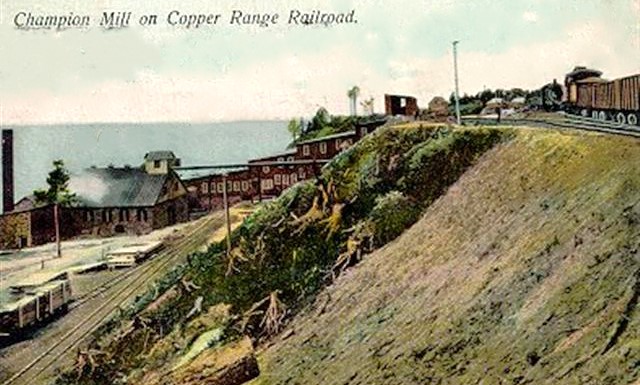- Details
- Hits: 3312
Mill: Champion Mill, Freda, MI
Began → Champion Mill → Closed
Operated for 64 years.
From: 1903
Owned by: Champion Mining Co.
Produced: Refined Copper Ore
Method: Stamp mill. 6 stamps with 3,500 ton daily capacity.
Railroad connection: Copper Range Railroad
Smelter: Michigan Smelter, Houghton
Until: 1967
Lifetime Production:

Image info: The Champion stamp mill at Freda looking north, in an early postcard view.
Notes
Refined copper from this mill was transported to the Michigan Smelter located at Cole's Creek west of Houghton (near the old Atlantic Mill) by the Copper Range railroad.
There were two framed trestles at Freda Mill, one 154 feet long and one 117 feet long. Built in 1902.
The Freda Mill had crushing, milling and concentration plants. They were originally steam operated, and then converted to electric power. Around 1940, a tailings reclamation plant was installed. [EDN-1947-0710]
The mill site included a pumphouse and intake tunnel, coal-handling equipment, a machine, carpenter and blacksmith shops, a warehouse and office, a laboratory for testing copper content of the rock, copper and tailings, a fire pump and hydrants, and a private telephone system. About 20 houses were built at Freda nearby for worker's houses. [HAL]
Time Line
1902. The mill was built by the Wisconsin Bridge & Iron Company from steel and concrete. It measured 178 x 215' and provided room for seven stamps. A railroad trestle delivered stamp rock to the bins at the high end of the structure, and the bins chuted rock to the stamps, each of which stood on a 15-foot-tall concrete foundation. The company pumped water in for the mill from Lake Superior via a 1,020 foot long tunnel. [HAL]
1902. There were three framed trestles at or near Freda Mill. #36 was 78' long. #37 was 155' long and #39 was 78' long.
1903. The Champion Mill is opened at Freda. [HAL]
1903. The mill initially housed four Nordberg stamps. The company experimented with gyratory crushers unsuccessfully,. Two more Nordberg stamps were installed for a total of six. The mill could process 3,500 tons daily.
1905. The office and lavatory at the Champion stamp mill at Freda burned, with Clerk Nelson burned to death. He was sleeping in the building. [SJDP-1905-1218]
1905. At a tour for area bankers and the press, it was noted that the four stamps at the Champion Mill showed incessant pounding and the process of saving copper was followed from where the rock from the mine was fed into the chute to the washing, where the fine copper is separated from the sand on rocking tables with grooved surfaces. This process being simply gravitation, there being no chemical attraction to catch and hold the copper. This process has been perfected so that above 80% of all the copper mined is secured. It is then transported by rail to the Michigan Smelter. [DFP-1905-0725]
1916. April 22. In the Sturgeon river district railroads are flooded to a depth of two feet. At Freda, the embankment, 40 feet high, supporting the mine spur of the Copper Range railroad is washed out. [HP-1916-0422]
1927. J.N. West, clerk of the Champion Copper company's stamp mill at Freda died in the Trimountain hospital Wednesday morning after a brief illness of pneumonia. He was taken to the hospital by special train. [IDG-1927-0721]
1967. The Copper Range company announces the closure of the Champion mine and mill. The mill at Freda has been more or less continuous operation for 60 years and employs 150 men. The mine will be maintained on a standby basis. [HDN-1967-0130]
1971. Mining Railway Being Removed. The rails of the Copper Range branch line between Mill Mine Junction and Freda, a milling town are being removed. Freda once was the location of the Champion Copper Mill, which crushed all Champion Mine rock for more than half a century. The Copper Range Railroad is a subsidiary of the Copper Range Co., which owns the White Pine Mines in Ontonagon County. [Escanaba Daily News, September 4, 1971]
Bibliography
The following sources are utilized in this website. [SOURCE-YEAR-MMDD-PG]:
- [AAB| = All Aboard!, by Willis Dunbar, Eerdmans Publishing, Grand Rapids ©1969.
- [AAN] = Alpena Argus newspaper.
- [AARQJ] = American Association of Railroads Quiz Jr. pamphlet. © 1956
- [AATHA] = Ann Arbor Railroad Technical and Historical Association newsletter "The Double A"
- [AB] = Information provided at Michigan History Conference from Andrew Bailey, Port Huron, MI

